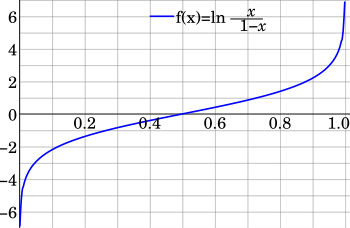Logit

In statistics, the logit (/ˈloʊdʒɪt/ LOH-jit) function or the log-odds is the logarithm of the odds where p is a probability.[1] It is a type of function that creates a map of probability values from to .[2] It is the inverse of the sigmoidal "logistic" function or logistic transform used in mathematics, especially in statistics.
Definition
If p is a probability, then p/(1 − p) is the corresponding odds; the logit of the probability is the logarithm of the odds, i.e.
The base of the logarithm function used is of little importance in the present article, as long as it is greater than 1, but the natural logarithm with base e is the one most often used. The choice of base corresponds to the choice of logarithmic unit for the value: base 2 corresponds to a shannon, base e to a “nat”, and base 10 to a hartley; these units are particularly used in information-theoretic interpretations. For each choice of base, the logit function takes values between negative and positive infinity.
The “logistic” function of any number is given by the inverse-logit:
The difference between the logits of two probabilities is the logarithm of the odds ratio (R), thus providing a shorthand for writing the correct combination of odds ratios only by adding and subtracting:
History
There have been several efforts to adapt linear regression methods to a domain where the output is a probability value, , instead of any real number . In many cases, such efforts have focused on modeling this problem by mapping the range to and then running the linear regression on these transformed values. In 1934 Chester Ittner Bliss used the cumulative normal distribution function to perform this mapping and called his model probit an abbreviation for "probability unit";.[3] However, this is computationally more expensive. In 1944, Joseph Berkson used log of odds and called this function logit, abbreviation for "logistic unit" following the analogy for probit. Log odds was used extensively by Charles Sanders Peirce (late 19th century).[4] G. A. Barnard in 1949 coined the commonly used term log-odds;[5] the log-odds of an event is the logit of the probability of the event.[6]
Uses and properties
- The logit in logistic regression is a special case of a link function in a generalized linear model: it is the canonical link function for the Bernoulli distribution.
- The logit function is the negative of the derivative of the binary entropy function.
- The logit is also central to the probabilistic Rasch model for measurement, which has applications in psychological and educational assessment, among other areas.
- The inverse-logit function (i.e., the logistic function) is also sometimes referred to as the expit function.[7]
- In plant disease epidemiology the logit is used to fit the data to a logistic model. With the Gompertz and Monomolecular models all three are known as Richards family models.
- The log-odds function of probabilities is often used in state estimation algorithms[8] because of its numerical advantages in the case of small probabilities. Instead of multiplying very small floating point numbers, log-odds probabilities can just be summed up to calculate the (log-odds) joint probability.[9][10]
Comparison with probit

Closely related to the logit function (and logit model) are the probit function and probit model. The logit and probit are both sigmoid functions with a domain between 0 and 1, which makes them both quantile functions – i.e., inverses of the cumulative distribution function (CDF) of a probability distribution. In fact, the logit is the quantile function of the logistic distribution, while the probit is the quantile function of the normal distribution. The probit function is denoted , where is the CDF of the normal distribution, as just mentioned:
As shown in the graph on the right, the logit and probit functions are extremely similar when the probit function is scaled, so that its slope at y = 0 matches the slope of the logit. As a result, probit models are sometimes used in place of logit models because for certain applications (e.g., in Bayesian statistics) the implementation is easier.
See also
- Sigmoid function, inverse of the logit function
- Discrete choice on binary logit, multinomial logit, conditional logit, nested logit, mixed logit, exploded logit, and ordered logit
- Limited dependent variable
- Daniel McFadden, a Nobel Prize in Economics winner for development of a particular logit model used in economics[3]
- Logit analysis in marketing
- Multinomial logit
- Ogee, curve with similar shape
- Perceptron
- Probit, another function with the same domain and range as the logit
- Ridit scoring
- Data transformation (statistics)
- Arcsin (transformation)
References
This article includes a list of general references, but it lacks sufficient corresponding inline citations. (November 2010) |
- ^ "LOG ODDS RATIO". nist.gov.
- ^ "Logit/Probit" (PDF).
- ^ a b J. S. Cramer (2003). "The origins and development of the logit model" (PDF). Cambridge UP.
- ^ Stigler, Stephen M. (1986). The history of statistics : the measurement of uncertainty before 1900. Cambridge, Massachusetts: Belknap Press of Harvard University Press. ISBN 978-0-674-40340-6.
- ^ Hilbe, Joseph M. (2009), Logistic Regression Models, CRC Press, p. 3, ISBN 9781420075779.
- ^ Cramer, J. S. (2003), Logit Models from Economics and Other Fields, Cambridge University Press, p. 13, ISBN 9781139438193.
- ^ "Archived copy". Archived from the original on 2011-07-06. Retrieved 2011-02-18.
{{cite web}}: CS1 maint: archived copy as title (link) - ^ Thrun, Sebastian (2003). "Learning Occupancy Grid Maps with Forward Sensor Models". Autonomous Robots. 15 (2): 111–127. doi:10.1023/A:1025584807625. ISSN 0929-5593.
- ^ Styler, Alex (2012). "Statistical Techniques in Robotics" (PDF). p. 2. Retrieved 2017-01-26.
- ^ Dickmann, J.; Appenrodt, N.; Klappstein, J.; Bloecher, H. L.; Muntzinger, M.; Sailer, A.; Hahn, M.; Brenk, C. (2015-01-01). "Making Bertha See Even More: Radar Contribution". IEEE Access. 3: 1233–1247. doi:10.1109/ACCESS.2015.2454533. ISSN 2169-3536.
Further reading
- Ashton, Winifred D. (1972). The Logit Transformation: with special reference to its uses in Bioassay. Griffin's Statistical Monographs & Courses. Vol. 32. Charles Griffin. ISBN 978-0-85264-212-2.












